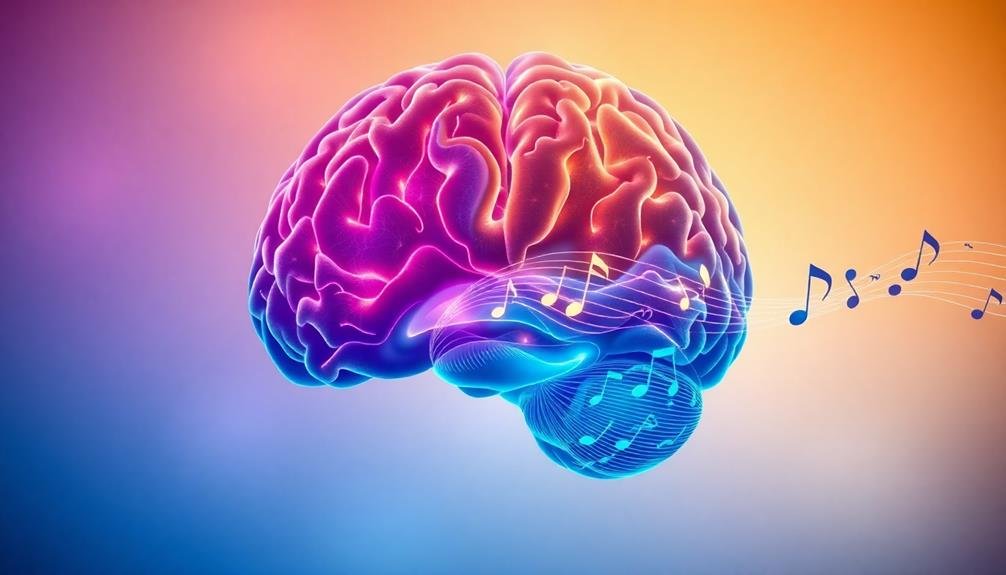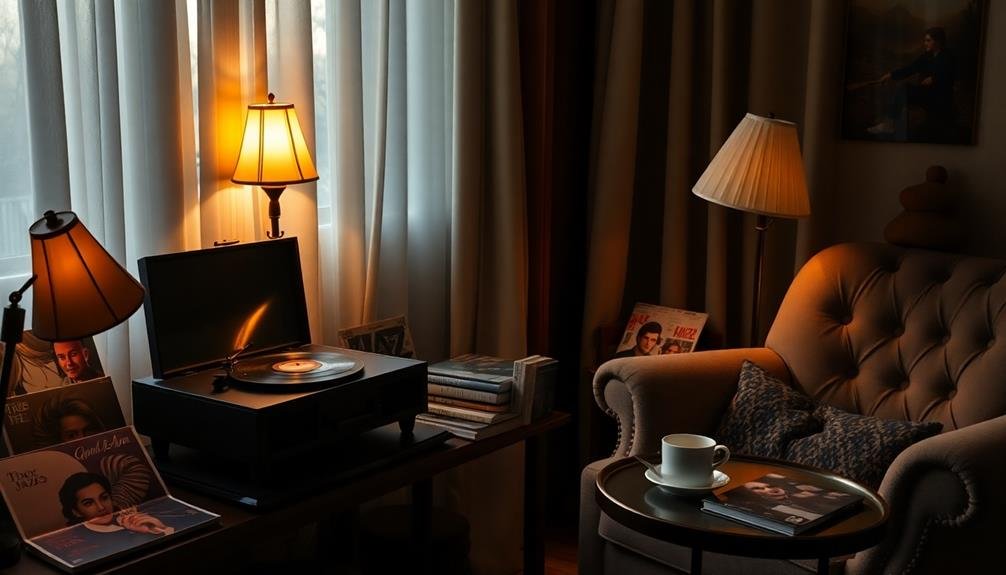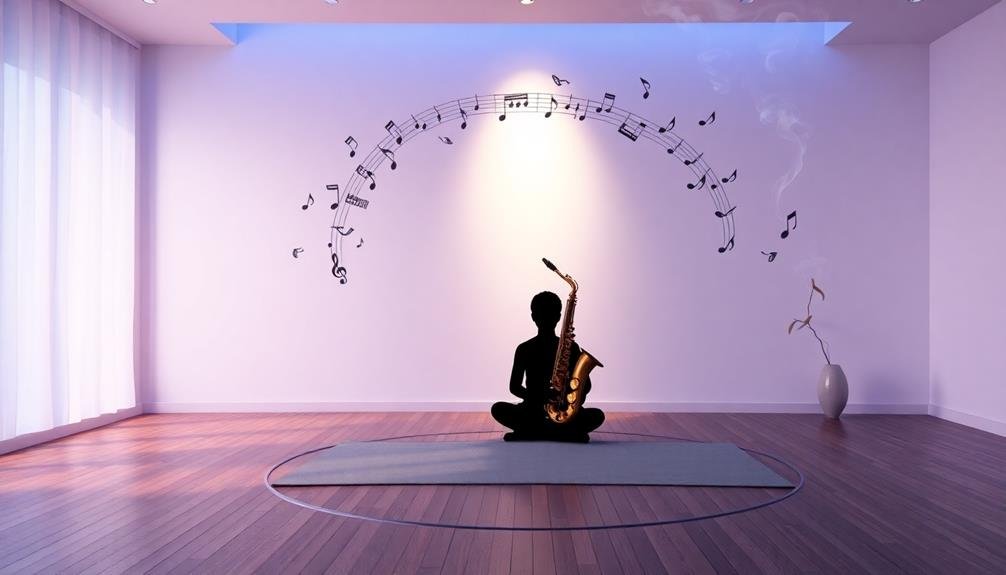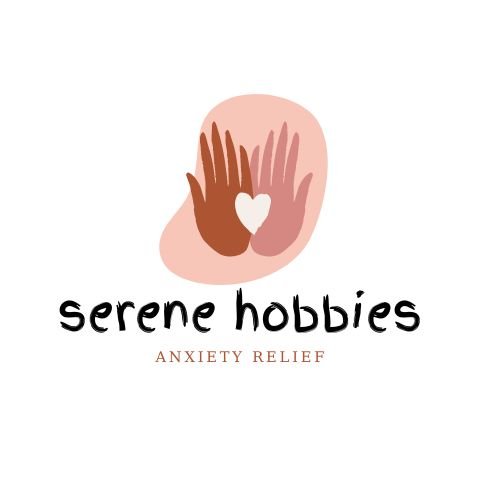Jazz offers a powerful therapeutic tool to calm your troubled mind and reduce anxiety. Its complex rhythms and improvisational nature activate various brain regions, promoting cognitive flexibility and emotional expression. Instruments like the saxophone, piano, and trumpet can soothe anxiety, lift spirits, and boost confidence. Create a relaxation playlist with slow-tempo tracks and soothing melodies from artists like Miles Davis and Bill Evans. Incorporate jazz into your daily routine, from morning wake-ups to evening wind-downs, to maximize its calming effects. Combine jazz with breathing exercises and mindful listening techniques for enhanced relaxation. Discover how this versatile genre can transform your mental well-being and bring harmony to your life.
The Science Behind Jazz Therapy

Three key factors contribute to jazz's therapeutic potential: rhythm, improvisation, and emotional expression. When you listen to jazz, your brain synchronizes with its complex rhythms, activating the areas responsible for motor control and timing. This synchronization can reduce stress and anxiety, improving your overall mood.
Improvisation in jazz mirrors the spontaneity of life, encouraging your brain to embrace flexibility and adaptability. As you engage with the unpredictable nature of jazz solos, you're training your mind to handle unexpected situations more effectively. This cognitive flexibility can help you cope with life's challenges and reduce symptoms of depression.
The emotional expression in jazz allows you to process and release your own feelings. The varied tones, from melancholic blues to upbeat swing, provide a cathartic outlet for your emotions. This emotional resonance activates your brain's limbic system, responsible for processing feelings and memories.
Neuroimaging studies have shown that listening to jazz increases connectivity between different brain regions, potentially enhancing cognitive function and creativity. By engaging multiple areas of your brain simultaneously, jazz therapy can promote neuroplasticity, helping you build new neural pathways and improve mental resilience.
Mood-Enhancing Jazz Instruments
Jazz's instrumental palette offers a rich array of mood-enhancing tools for your mental well-being. The saxophone, with its sultry tones, can evoke deep emotions and help you process complex feelings. Its smooth, warm sound might soothe anxiety or lift your spirits when you're feeling low.
You'll find the piano's versatility particularly therapeutic. Its melodic lines can provide comfort, while its rhythmic patterns may help ground you during stressful times.
The trumpet's bright, assertive voice can boost your confidence and energy levels, potentially alleviating symptoms of depression.
Don't overlook the double bass; its deep, resonant tones can create a sense of stability and security. The drums, with their varied textures and rhythms, can help regulate your heartbeat and breathing, promoting relaxation or energizing you as needed.
For a gentler approach, consider the clarinet. Its mellow timbre can ease tension and promote a sense of calm.
The guitar's intimate sound may foster feelings of connection and comfort, particularly beneficial if you're experiencing loneliness or isolation.
Creating a Jazz Relaxation Playlist

Crafting a personalized jazz relaxation playlist can be a powerful tool for managing stress and improving your mental well-being. Start by selecting slow-tempo tracks with soothing melodies and gentle rhythms. Look for pieces featuring instruments known for their calming effects, such as piano, saxophone, and guitar.
Include a mix of instrumental and vocal jazz, focusing on ballads and cool jazz styles. Consider artists like Miles Davis, Bill Evans, and Chet Baker, known for their mellow sounds. Don't forget to add some bossa nova tracks, which blend jazz with Brazilian rhythms for a relaxing tropical vibe.
Organize your playlist to create a natural flow, starting with slightly more upbeat songs and gradually shifting to slower, more meditative pieces. Aim for a playlist duration of 30 to 60 minutes, perfect for a relaxation session or background music during work or study.
Remember to update your playlist regularly, adding new discoveries and removing songs that no longer resonate with you. Experiment with different subgenres and artists to keep your relaxation experience fresh and engaging.
With a well-curated jazz playlist, you'll have a reliable source of calm whenever you need it.
Famous Jazz Artists for Anxiety
When it comes to soothing anxiety with jazz, certain artists stand out for their calming compositions and performances. You'll find that these musicians have mastered the art of creating tranquil atmospheres through their music, making them ideal for easing your troubled mind.
Bill Evans, known for his introspective piano style, offers a gentle touch that can help calm your nerves. Miles Davis's cool jazz period, particularly his album "Kind of Blue," provides a serene backdrop for relaxation. For a more contemporary sound, you might turn to Norah Jones, whose soulful voice and mellow arrangements can be incredibly soothing.
Here's a quick reference guide to some famous jazz artists and their anxiety-reducing qualities:
| Artist | Anxiety-Reducing Quality |
|---|---|
| Bill Evans | Introspective piano |
| Miles Davis | Cool, laid-back trumpet |
| Norah Jones | Soothing vocals |
| Stan Getz | Smooth saxophone |
| Diana Krall | Elegant piano and voice |
Breathing Exercises With Jazz Music

Combining jazz music with breathing exercises can kick your relaxation up a notch. As you settle into a comfortable position, choose a slow, mellow jazz piece with a steady rhythm. Focus on the bass line or drumbeat, using it as a guide for your breath.
Begin with a simple 4-4-4 technique: Inhale for four counts, hold for four, then exhale for four. Sync your breath with the music's tempo, allowing the smooth jazz tones to deepen your relaxation. As you become more comfortable, try extending your exhale to six or eight counts, promoting further calm.
For a more immersive experience, visualize the different instruments as you breathe. Imagine the saxophone's warm tones filling your lungs on the inhale, and release tension with the soft piano notes on the exhale. Pay attention to how the music affects your body, noting any areas of tightness or release.
Experiment with different jazz styles and tempos to find what works best for you. Remember, the goal is to create a harmonious connection between the music, your breath, and your mind.
Jazz Genres for Different Anxiety
Jazz, with its diverse subgenres, offers a unique soundtrack for various types of anxiety.
For general anxiety, you might find solace in cool jazz. Its relaxed tempo and smooth melodies can help calm racing thoughts and promote a sense of ease. Artists like Miles Davis and Chet Baker are excellent choices for this purpose.
If you're dealing with social anxiety, consider bebop. Its fast-paced, complex rhythms can distract your mind from overthinking social situations. Charlie Parker and Dizzy Gillespie's energetic tunes might help boost your confidence before social events.
For those experiencing panic attacks, modal jazz could be beneficial. Its repetitive, hypnotic qualities can help ground you in the present moment. John Coltrane's "A Love Supreme" is a prime example of this style.
If you're struggling with generalized anxiety disorder, try Latin jazz. Its upbeat rhythms and lively melodies can lift your mood and reduce overall tension. Explore the works of Stan Getz or Tito Puente to experience the energizing effects of this genre.
Incorporating Jazz Into Daily Routine

You can seamlessly integrate jazz into your daily life to reap its calming benefits.
Start your day with an energizing Morning Jazz Wake-Up, take a Lunchtime Smooth Jazz Break to reset your mind, and end your evening with a soothing Jazz Relaxation Ritual.
These simple routines will help you harness the therapeutic power of jazz throughout your day.
Morning Jazz Wake-Up
Starting your day with the smooth sounds of jazz can set a positive tone for the hours ahead. As you wake up, consider creating a playlist of gentle jazz tunes to ease you into consciousness. Begin with soft, instrumental pieces featuring mellow piano or saxophone solos. Gradually increase the tempo and complexity as you become more alert.
While preparing for your day, let the rhythmic beats and harmonious melodies accompany your morning routine. You'll find that jazz's improvisational nature can inspire creativity and flexible thinking, helping you approach the day's challenges with a fresh perspective.
As you sip your morning coffee or tea, pay attention to the interplay between instruments, allowing the music to stimulate your mind gently.
Don't hesitate to experiment with different jazz subgenres to find what resonates with you. Whether it's cool jazz, bebop, or swing, each style offers unique benefits for mental stimulation and relaxation.
Lunchtime Smooth Jazz Break
As the morning gives way to midday, your mind and body may benefit from an invigorating musical interlude. A lunchtime smooth jazz break can provide the perfect respite from your busy day, helping you reset and refocus for the afternoon ahead.
Choose tracks with mellow, relaxing rhythms and soothing melodies. Artists like Kenny G, Dave Koz, or Boney James offer excellent options for your midday jazz session. As you listen, practice deep breathing exercises to enhance the calming effect. Take slow, deliberate breaths, allowing the music to guide your rhythm.
Consider creating a dedicated playlist for your lunchtime jazz break, curating songs that resonate with you and promote a sense of tranquility. If possible, find a quiet spot to enjoy your music, perhaps near a window or in an outdoor setting.
As you immerse yourself in the smooth jazz sounds, let go of morning stressors and prepare your mind for the tasks ahead. This brief musical interlude can improve your mood, increase productivity, and provide a much-needed mental reset.
Make your lunchtime smooth jazz break a daily ritual to cultivate a more balanced and focused approach to your workday.
Evening Jazz Relaxation Ritual
While the day winds down, establishing an evening jazz relaxation ritual can be a powerful way to decompress and shift into a restful night. Create a soothing environment by dimming the lights, lighting a scented candle, and settling into a comfortable chair. Choose a jazz playlist that matches your mood, whether it's mellow ballads or gentle bossa nova rhythms.
As you listen, practice deep breathing exercises to further relax your body and mind. Focus on the intricate melodies, harmonies, and improvisation in the music. Let the gentle rhythms guide you into a state of calm and reflection.
Here's a suggested evening jazz relaxation ritual:
| Time | Activity | Jazz Style | Benefit |
|---|---|---|---|
| 8:00PM | Light candle, dim lights | Smooth Jazz | Set relaxing ambiance |
| 8:15PM | Deep breathing exercises | Cool Jazz | Reduce stress |
| 8:30PM | Journaling or light reading | Bossa Nova | Reflect on the day |
| 9:00PM | Gentle stretching | Ballads | Prepare body for sleep |
Mindful Listening Techniques for Jazz
When you're ready to plunge into the world of jazz, mindful listening techniques can enhance your experience and therapeutic benefits.
Start by finding a quiet, comfortable space where you won't be disturbed. Close your eyes and take a few deep breaths to center yourself.
As the music begins, focus on individual instruments. Notice how the saxophone's smooth tones intertwine with the piano's rhythmic chords. Pay attention to the bass line, grounding the piece, and the drums keeping time.
Don't try to analyze the music; simply let it wash over you.
If your mind wanders, gently bring your attention back to the sounds. Try to identify emotions the music evokes. Does a particular melody make you feel calm, energized, or nostalgic? Observe these feelings without judgment.
Practice active listening by engaging your body. Tap your foot to the rhythm or sway gently to the beat. This physical connection can deepen your immersion in the music.
Jazz-Inspired Meditation Practices

Jazz-inspired meditation practices blend the soulful rhythms of this genre with traditional mindfulness techniques. You can start by creating a comfortable space and selecting a jazz piece with a slow, steady tempo. As you listen, focus on your breath, synchronizing it with the music's rhythm. Let the melody guide your inhales and exhales, allowing tension to melt away with each note.
Try visualizing the instruments as you meditate. Imagine the smooth saxophone tones flowing through your body, or the gentle piano keys releasing stress from your muscles. You can also use jazz scatting as a unique mantra, repeating soft, wordless sounds in tune with the music.
For a more active practice, engage in gentle movement inspired by the music. Sway or tap your fingers to the beat, letting your body become an extension of the melody. This can help you stay present and connected to the music.
Combining Jazz With Other Therapies
The therapeutic benefits of jazz can be amplified when combined with other healing modalities. You'll find that pairing jazz with various therapies can create a synergistic effect, enhancing your overall well-being.
Consider integrating jazz into your art therapy sessions, allowing the music to inspire your creative expression and emotional release. As you paint or sculpt, let the rhythms guide your movements and the melodies influence your color choices.
For those undergoing cognitive behavioral therapy, jazz can serve as a powerful tool for mood regulation and mindfulness exercises. You might use specific jazz tracks to anchor positive emotions or practice grounding techniques during challenging moments.
In physical therapy settings, jazz's varied tempos can assist in pacing exercises and improving coordination. Slower ballads may accompany gentle stretching, while upbeat swing tunes could energize more intense rehabilitation activities.
Massage therapists often incorporate jazz to create a relaxing atmosphere, helping you unwind both mentally and physically.
You can also explore combining jazz with aromatherapy, selecting scents that complement the music's mood to further enhance relaxation or invigoration.
Frequently Asked Questions
Can Jazz Therapy Help With Physical Pain Management?
You'll find jazz therapy can indeed help manage physical pain. It's proven to reduce stress, lower blood pressure, and release endorphins. The rhythmic patterns and soothing melodies can distract you from discomfort and promote relaxation.
Are There Any Potential Side Effects of Using Jazz for Anxiety Relief?
You'll find jazz therapy for anxiety generally safe, but be aware of potential side effects. You might experience heightened emotions, increased heart rate, or insomnia. If you're sensitive to certain sounds, jazz could trigger discomfort or overstimulation.
How Does Jazz Compare to Classical Music for Stress Reduction?
You'll find both jazz and classical music can reduce stress effectively. While classical often provides structured calm, jazz's improvisational nature might engage your mind differently. Your personal taste plays a big role in determining which works best for you.
Can Children Benefit From Jazz Therapy for Emotional Regulation?
Yes, jazz therapy can help your child regulate emotions. It's engaging, improvisational nature encourages self-expression and creativity. You'll find that jazz's rhythms and melodies can soothe anxiety, boost mood, and improve focus in children.
Is Live Jazz More Effective Than Recorded Jazz for Therapeutic Purposes?
You'll likely find live jazz more effective for therapy. It offers a unique, immersive experience with real-time interactions and vibrations you can feel. However, recorded jazz can still be beneficial if live performances aren't accessible.
In Summary
You've now explored the healing power of jazz for your mind and mood. By incorporating these melodic rhythms into your daily life, you're giving yourself a powerful tool for relaxation and anxiety relief. Remember, it's not just about listening—it's about engaging with the music mindfully. Whether you're practicing breathing exercises or meditating to smooth saxophones, jazz can be your constant companion in the journey towards mental wellness. Keep grooving and stay calm!





Leave a Reply